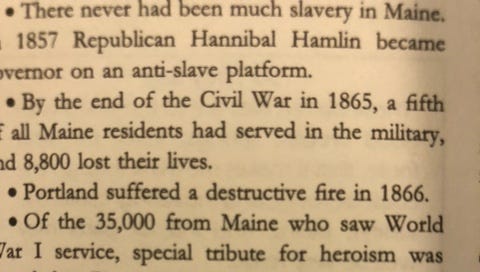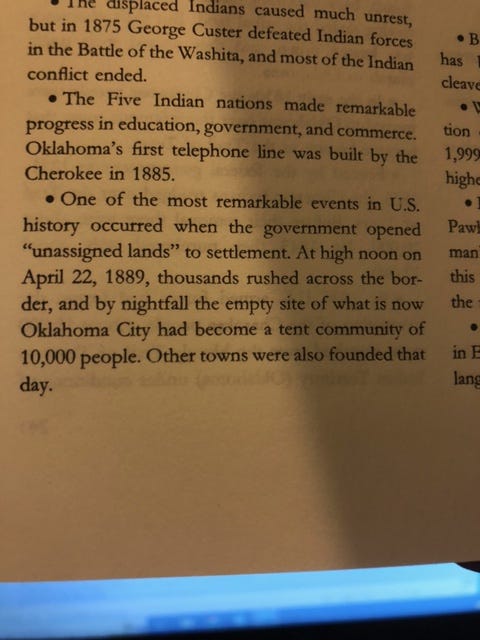Week 121: The World Almanac of the U.S.A.
What a 28-year old text can tell us about the history of quiz bowl and televised quizbowl.
[I am pasting this into substack on Wednesday morning from a resort outside of Atlantic City overlooking a golf course overlooking the ocean. Catie will be at a dance competition on the Boardwalk for the rest of this week, so I am rising early, and typing before the day’s drama unfolds. This week is giving me lots of morning time to type, and I’ve made a good deal of progress on the book. But I had written this last week, in case I hadn’t had that time, so I’m just going to paste this in, and tell you a story of a book I waited 28 years to thumb through.]
In cleaning out my aunt’s house I pulled some books for myself, one of which was a book that I knew existed and had thought about buying at the time, and a couple times that I saw it in used bookstores, but never pulled the trigger. But I had recognized the bright yellow cover from a distance, and knew that I had to put it in the box to go home with me. This was The World Almanac of the U.S.A.
The World Almanac of the U.S.A. was published in 1994. Its unwieldy title came from the fact it was produced by the editors of The World Almanac, and it was designed to be sold for a short time (there’s a note on its cover to “Display until 3/31/94”.) It looks to have been an experiment to see if the World Almanac brand could expand their brand to publish a second volume in the early part of the year, when the year dated regular almanac would be like a calendar, losing value with every day.
The basic structure of the book is that each state and territory is listed, then given a basic history, and then data on the state is compiled for the reader. The data in these sections are mostly repackaged from the 1994 World Almanac, but instead of being tables covering all the states’ results, the data is broken out for each state. You wouldn’t repackage information like this today, because it’s too easy to do on computer, rather than lock the data onto a printed page for mass production. You’d just see it separated into its individual pages, and the links changed, and a final printed product, if it were ever done, would be customized for a few people at most.
This was a thing that was sold in grocery stores, by the checkout with the Farmer’s Almanac, small cookbooks, and Weekly World News. It was also sold to libraries as a reference book. If you had been writing questions in 1994 you would have run across it, and been intrigued by it, but you wouldn’t have necessarily bought it.
I realize the description of this may seem ‘low-class’ as a reference source today, but for the era it would have been perfectly acceptable as a starting point for both inspiration and clues for a question. You had to start somewhere with inspiration for writing, and having a general reference source that could inspire writing in a number of categories was invaluable to packet production.
The piece that would have been useful to quiz bowl writers would have been the state histories. What’s striking to me about these histories is that they contain clues that I would have expected to appear at some point in quiz bowl, but which I have no memory of them making it into questions.
Because it was published in 1994, it stands right on the endpoint of when the standard for writing and editing questions were physical sources. But at that point the internet was highly incomplete as a set of references, and while the circuit used it for the transport of questions to editors, the circuit didn’t really use it for the research of questions. And before this would have migrated into places where it could have been used for research, the circuit had moved onto internet sources.
It reflects a different mindset and different method of obtaining information. This is prose written from primitive data mining. This is seeing a pattern and writing from the pattern. The statement in that fact from Oklahoma was probably the result of seeing multiple entries in the data on founding of cities and realizing all of the Oklahoma ones with the same date were the date of the Oklahoma Land Rush. The fire data for Portland would have been in multiple volumes of the almanac under largest fires in the United States, or largest disasters, or some other table. Given it was the largest fire in the US prior to the Great Chicago Fire, it had to appear as a data point in the almanac.
I think this would have been remembered much more fondly if it had been created and circulated about two years earlier. It fulfills a slot for US geographic clues which was analogous to the role the CIA World Factbook served for clues about world geography, or Benet’s Reader’s Encyclopedia did for literature clues, a baseline canon that would have served a new player well. I certainly could have seen it having a long career in televised quiz bowl, where answers that are US states are always welcome. But now it’s more a curiosity. I’m happy I finally got to read through it, but it’s probably not even a good prize to give away these days.
The move of USC and UCLA to the Big Ten prompted a modification to a section I was editing, relating to clues about colleges and universities, which I touched on in Week 31. I’m noting it here because having seen the effect on questions that the previous major waves of conference movements have, I think I can generalize the effects:
“When colleges change their nicknames, there is a momentary increase in interest, but it recedes quickly. But when colleges change their conference, there's a drop in interest in even asking questions or referring to clues about athletic conferences.”




